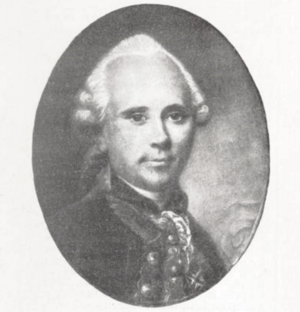François Hector d'Albert de Rions facts for kids
Quick facts for kids
François Hector d'Albert de Rions
|
|
|---|---|
 |
|
| Born | 2 February 1728 Avignon |
| Died | 2 October 1802 (aged 74) Saint-Auban-sur-l'Ouvèze |
| Occupation | Military personnel |
| Rank | contre-amiral |
François Hector d’Albert, comte de Rioms (born February 19, 1728, in Avignon – died October 2, 1802, in Saint-Auban-sur-l'Ouvèze) was a brave French Navy officer. He served during the American Revolutionary War, which is also known as the War of American Independence. For his service, he became a member of the Society of Cincinnati, a special group for officers who fought in that war.
Contents
François Hector d'Albert de Rions came from a family with a military background; his father was an Army general. He began his own naval journey on December 26, 1743, when he joined the Navy as a Garde-Marine. This was like being a naval cadet, learning the ropes of sea life.
In his early career, he helped protect ships carrying goods in the Caribbean Sea in 1746. He also sailed near Tripoli in 1752, keeping an eye on things. He was promoted to Lieutenant on May 15, 1756, showing his dedication and skill.
Captured by the British
During his service, Albert de Rions was captured by the British forces twice. The first time was in 1755 at Louisbourg. After being freed in 1757, he was captured again at the Battle of Cartagena on February 28, 1758. Being captured was a common risk for naval officers during wartime.
Commanding Ships and Battles
From 1768, Albert de Rions commanded a 20-gun ship called the Séduisant. This ship was a type of vessel known as a xebec, which was fast and used in the Mediterranean Sea. He sailed between Toulon and Livorno and took part in the French conquest of Corsica.
He was promoted to Captain on February 18, 1772. This was a significant step in his career.
American Revolutionary War Service
In 1778, he commanded the 50-gun ship Sagittaire. He was part of a large French fleet led by Admiral D'Estaing. During this time, he fought in important battles that helped the American colonies gain their independence.
- He participated in the Battle of Grenada on July 6, 1779.
- He also took part in the naval part of the Siege of Savannah.
- On September 23, 1779, his ship captured a British ship, the 50-gun HMS Experiment. This ship was then added to the French Navy.
Later, he was given command of even larger ships. He commanded the 74-gun Marseillais before moving to the Pluton. With these powerful ships, he continued to fight in major naval engagements:
- The Battle of the Chesapeake on September 5, 1781.
- The Battle of Saint Kitts on January 25, 1782.
- The Battle of the Saintes on April 12, 1782.
Later Career and Challenges
On August 20, 1784, he was promoted to Chef d'Escadre, which was a high rank, similar to a rear admiral. From January 1, 1785, he became the commander of the Navy in Toulon, an important naval port in France.
The next year, he helped organize a special event for King Louis XVI. It was a simulated naval battle using the 74-gun ship Patriote in Cherbourg.
Unrest in Toulon
In January 1788, he was again appointed commander of the naval forces in Toulon. This was a difficult time in France, leading up to the French Revolution. The workers at the Toulon arsenal, where ships were built and repaired, faced very tough conditions.
- Their pay was extremely low.
- They often found work only every second or third day.
- Due to financial problems in the country, their pay was often delayed.
- A bad harvest in 1789 and a harsh winter made things even worse, causing food prices to rise sharply.
These problems led to great hardship and unhappiness among the workers. Albert de Rions responded strictly to their complaints, even forbidding them from wearing special ribbons called cockades, which were becoming symbols of the revolution. This made the workers even more upset.
On December 1, 1789, the workers at the Toulon arsenal protested strongly and held him. The National Assembly, which was the new government body, ordered his release. He was then replaced by Joseph de Flotte. Albert de Rions was later appointed commander of the Brest squadron, another naval base, but he found it hard to restore order there as well.
Final Years
He was promoted to contre-amiral (rear admiral) on January 1, 1792. However, with the French Revolution gaining strength, he chose to leave France and join the Armée des Princes, a group of royalists who opposed the revolution. He returned to France in 1801 and retired from military life. He passed away on October 2, 1802, at the age of 74.

